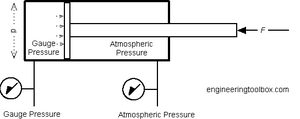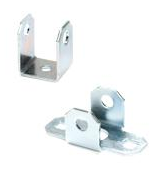Pneumatic Cylinders
Pneumatic Cylinders sometimes known as air cylinders are mechanical devices which use the power of compressed gas to produce a force in a reciprocating linear motion.Like Hydraulic Cylinders, pneumatic cylinders use the stored potential energy of a fluid, in this case compressed air, and convert it into kinetic energy as the air expands in an attempt to reach atmospheric pressure. This air expansion forces a piston to move in the desired direction. The piston is a disc or cylinder, and the piston rod transfers the force it develops to the object to be moved. Engineers prefer to use pneumatics sometime because they are quieter, cleaner, and do not require large amounts of space for fluid storage.Because the operating fluid is a gas, leakage from a pneumatic cylinder will not drip out and contaminate the surroundings, making pneumatics more desirable where cleanliness is a requirement.
Operation
General
Once actuated, compressed air enters into the tube at one end of the piston and, hence, imparts force on the piston. Consequently, the piston becomes displaced (moved) by the compressed air expanding in an attempt to reach atmospheric pressure.
Compressibility of gasses
One major issue engineers come across working with pneumatic cylinders has to do with the compressibility of a gas. Many studies have been completed on how the precision of a pneumatic cylinder can be affected as the load acting on the cylinder tries to further compress the gas used. Under a vertical load, a case where the cylinder takes on the full load, the precision of the cylinder is affected the most. A study at the National Cheng Kung University in Taiwan, concluded that the accuracy is about ± 30mm, which is still within a satisfactory range but shows that the compressibility of air has an effect on the system.
Fail safe mechanisms
Pneumatic systems are often found in settings where even rare and brief system failure is unacceptable. In such situations locks can sometimes serve as a safety mechanism in case of loss of air supply and or abate any damage arising in such a situation. Due to the leakage of air from input or output reduces the pressure and so the desired output.
Types
Although pneumatic cylinders will vary in appearance, size and function, they generally fall into one of the specific categories shown below. However there are also numerous other types of pneumatic cylinder available, many of which are designed to fulfill specific and specialized functions.
Single-acting cylinder
Single-acting cylinders (SAC) use the pressure imparted by compressed air to create a driving force in one direction , and a spring to return to the home position. More often than not, this type of cylinder has limited extension due to the space the compressed spring takes up. Another downside to SACs is that part of the force produced by the cylinder is lost as it tries to push against the spring. Because of those factors, single acting cylinders are recommended for applications that require no more than 100mm of stroke length.
Double-acting cylinders
Double-acting cylinders (DAC) use the force of air to move in both extend and retract strokes. They have two ports to allow air in, one for outstroke and one for instroke. Stroke length for this design is not limited, however, the piston rod is more vulnerable to buckling and bending. Addition calculations should be performed as well.
Multi-stage, telescoping cylinders
Telescoping cylinders, also known as telescopic cylinders can be either single or double-acting. The telescoping cylinder incorporates a piston rod nested within a series of hollow stages of increasing diameter. Upon actuation, the piston rod and each succeeding stage telescopes out as a segmented piston. The main benefit of this design is the allowance for a notably longer stroke than would be achieved with a single-stage cylinder of the same collapsed length. One cited drawback to telescoping cylinders is the increased potential for piston flexion due to the segmented piston design. Consequently, telescoping cylinders are primarily utilized in applications where the piston bears minimal side loading.
Rodless cylinders
Some rodless types have a slot in the wall of the cylinder that is closed off for much of its length by two flexible metal sealing bands. The inner one prevents air from escaping, while the outer one protects the slot and inner band. The piston is actually a pair of them, part of a comparatively long assembly. They seal to the bore and inner band at both ends of the assembly. Between the individual pistons, however, are camming surfaces that peel off the bands as the whole sliding assembly moves toward the sealed volume, and replace them as the assembly moves away from the other end. Between the camming surfaces is part of the moving assembly that protrudes through the slot to move the load. Of course, this means that the region where the sealing bands are not in contact is at atmospheric pressure.

